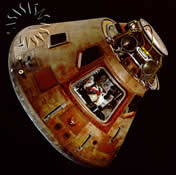The Apollo 11 Command Module "Columbia" carried astronauts Neil Armstrong, Edwin "Buzz" Aldrin, and Michael Collins on their historic voyage to the Moon and back on July 16-24, 1969. This mission culminated in the first human steps on another world. The Apollo 11 spacecraft had three parts: the
Command Module, the Service Module, and the Lunar Module "Eagle".
While astronauts Armstrong and Aldrin descended to the Moon in "Eagle",
Michael Collins remained alone in "Columbia". For 28 hours he served
as a communications link and photographed the lunar surface. After
reclaiming Armstrong and Aldrin from the ascent stage of the Lunar
Module, "Columbia" was the only part of the spacecraft to return
to Earth. The blunt-end design for the Command Module was chosen to build upon experience gained with the similarly shaped Mercury and Gemini spacecraft. The spacecraft reentered the atmosphere with its protective heat shield facing forward. Layers of special "ablative" material on the shield were purposely allowed to burn away during reentry to help dissipate the extremely high temperatures caused by atmospheric friction.
|
![]() 1965
Gemini IV | Milestones of Flight | 1972
Lunar Touchrock
1965
Gemini IV | Milestones of Flight | 1972
Lunar Touchrock ![]()
©National Air and Space Museum

